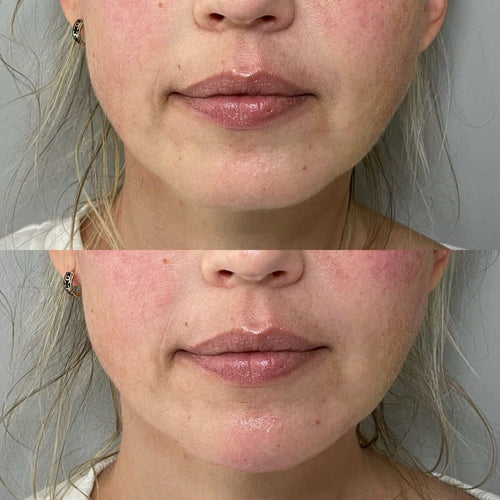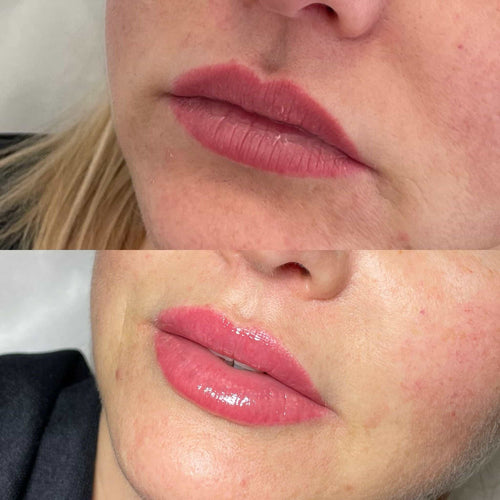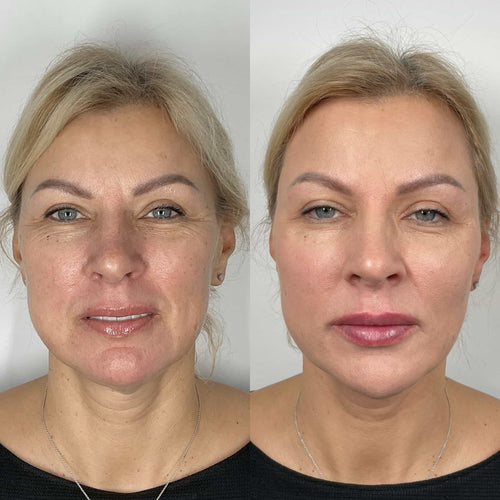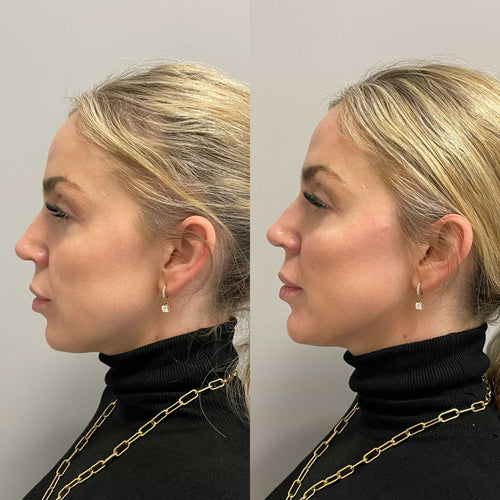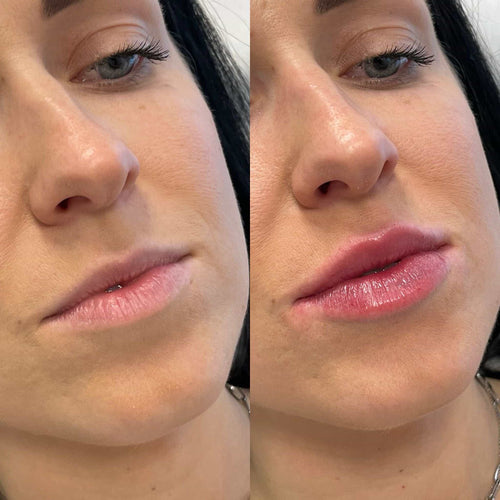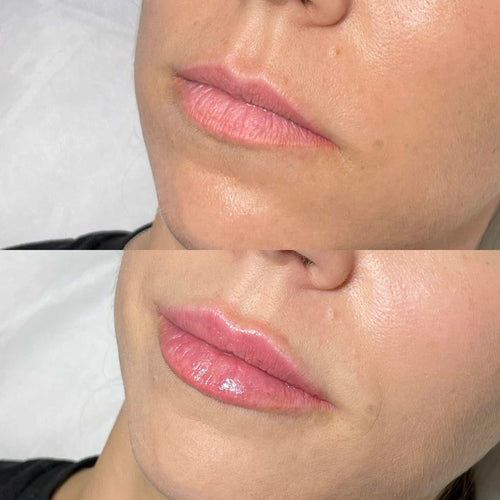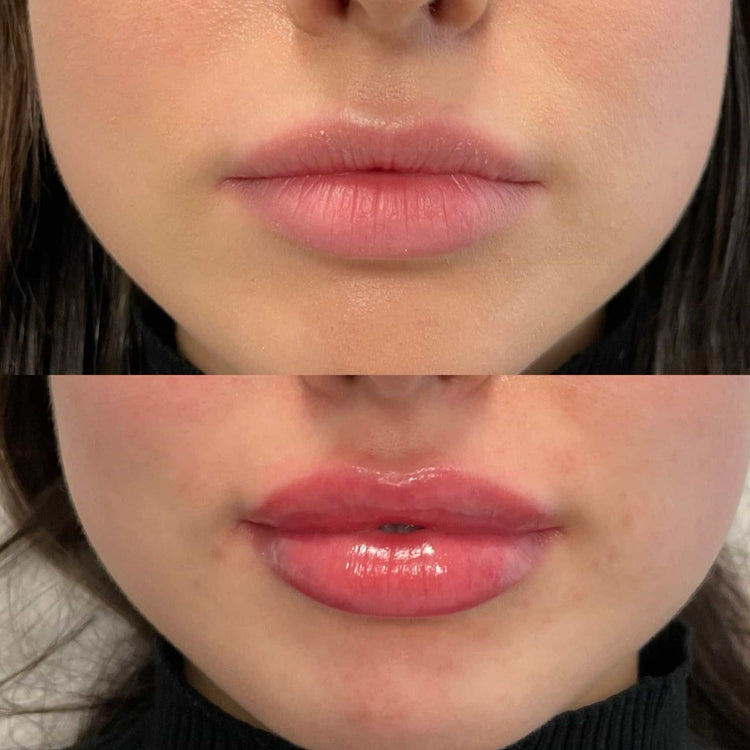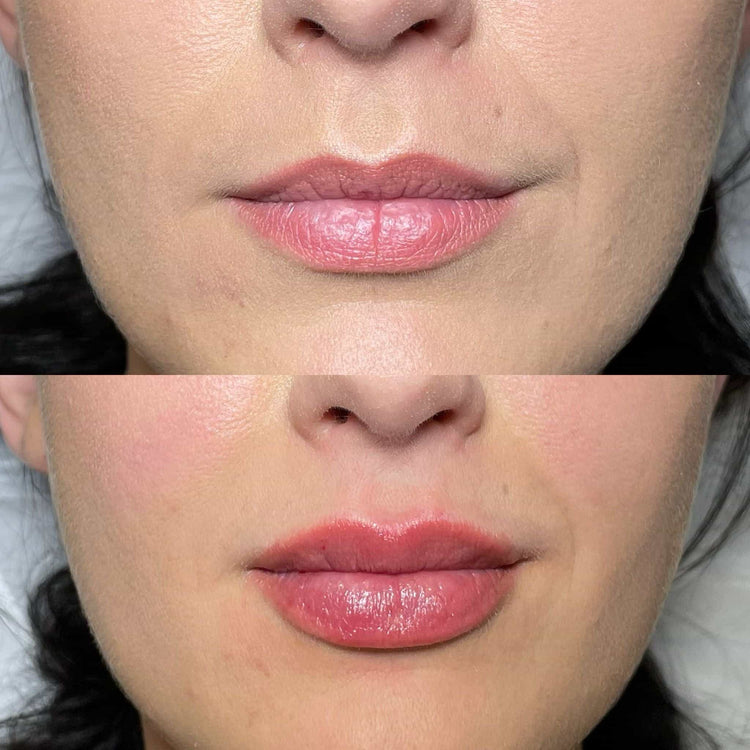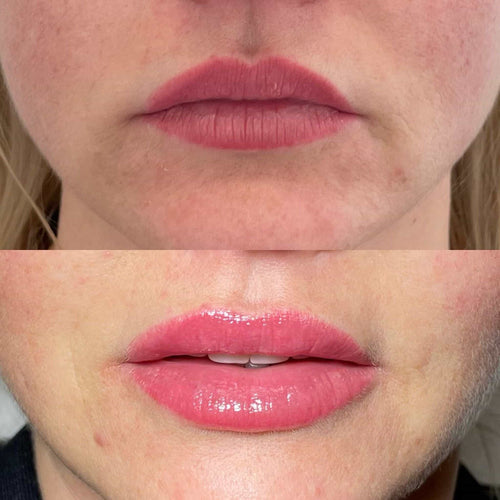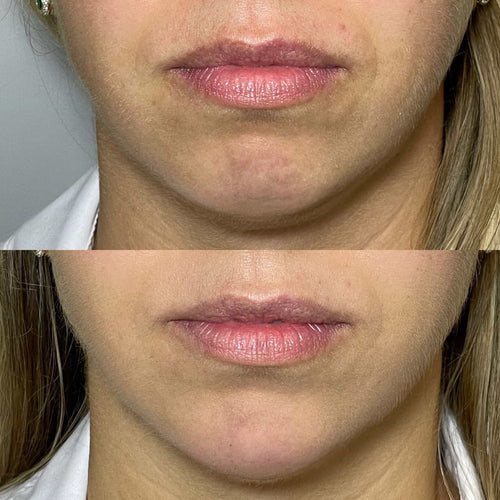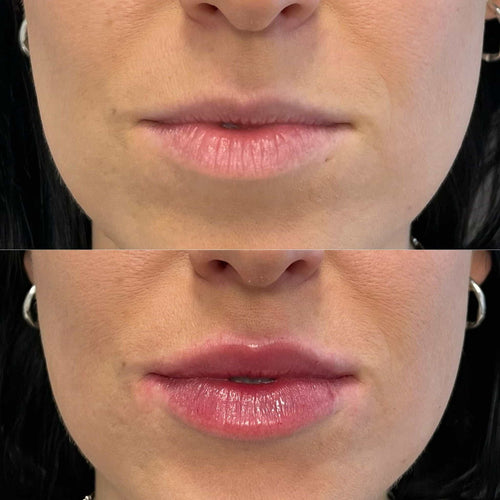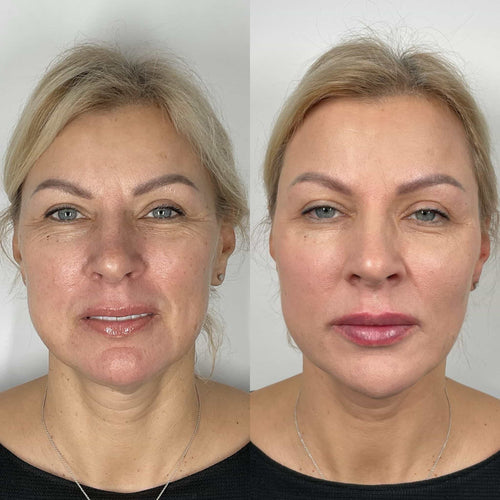Get Your Dermal Filler Consultation with Dr. Laura Geige Today
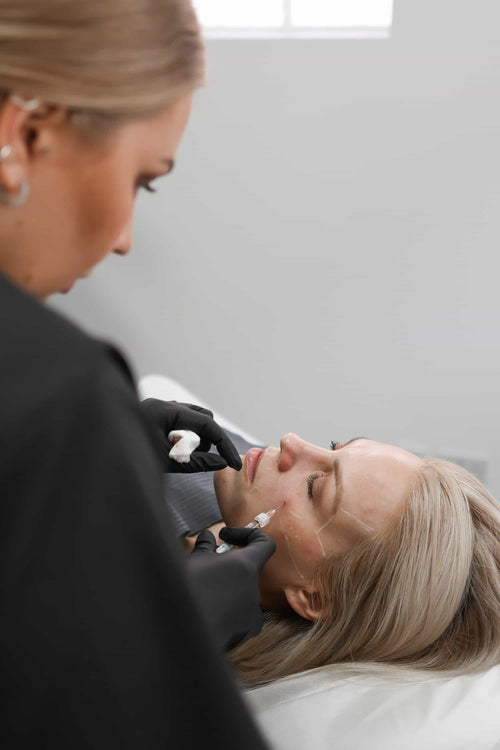
Factors Affecting Lip Filler Dissolution Rates
The dissolution rate of lip fillers plays a crucial role in determining how long they last and how effective they are for achieving desired results.
Several factors can influence the rate at which lip fillers dissolve, including:
-
The type of filler material used: Different materials have varying rates of dissolution. For example, hyaluronic acid fillers tend to break down faster than calcium hydroxylapatite (CaHA) fillers.
-
The concentration of the filler material: Higher concentrations of the active ingredient can lead to faster dissolution rates.
-
The presence of enzymes: Enzymes such as hyaluronidase, which breaks down hyaluronic acid, can accelerate the dissolution rate of lip fillers.
-
The pH level of the skin: A more acidic environment can slow down the dissolution process, while a more alkaline environment can speed it up.
-
The presence of other substances in the skin:
- Antibiotics and antiseptics can alter the skin’s pH and affect the filler’s dissolution rate
- Growth factors and platelet-rich plasma (PRP) can stimulate collagen production, which may influence the longevity of the fillers
- Steroids and certain medications can reduce blood flow to the area, slowing down the dissolving process
-
The age of injection: The rate at which lip fillers dissolve can be influenced by when they are injected.
- Hyaluronic acid fillers tend to break down within 6-12 months, while CaHA fillers can last up to 2 years or more.
- The rate of dissolutions is typically faster in younger patients, as the skin’s natural turnover rates are higher.
- Age:** The rate at which lip fillers dissolve can increase with age. Studies suggest that Juvederm and Restylane dissolve more slowly with age, taking up to 612 months (or around 51 years) to break down.
- Skin Type:** The rate of dissolution can also vary depending on individual skin types. People with dry or sensitive skin may experience a slower breakdown of lip fillers due to reduced blood flow and increased inflammation.
- Filler Type and Size:** Different types and sizes of lip fillers have varying dissolution rates. Larger fillers tend to take longer to dissolve than smaller ones.
-
Higher body temperatures increase the rate of hyaluronic acid breakdown
-
Exercise and physical activity also accelerate the dissolution process as it causes blood circulation to increase and generates heat, leading to faster breakdown of hyaluronic acid.
-
Smoking and other vasoconstrictors can slow down or inhibit the breakdown process by reducing blood flow, which slows down the rate at which lip filler dissolves
-
A humid climate may lead to faster dissolution as high humidity contributes to higher temperatures.
-
Moisture exposure can also contribute to the faster breakdown of hyaluronic acid, particularly if it comes into contact with excessive amounts of water or other substances that compromise its structural integrity
-
Using heat packs, hot water bottles, or saunas close to lip area may cause the filler material to break down quicker due to increased body temperatures.
-
Age and overall health of an individual can also impact how quickly the hyaluronic acid is broken down by the body
-
Genetic predisposition to faster or slower metabolic rates may influence how quickly lip filler dissolves in a given individual.
-
Dietary factors, including consumption of certain nutrients and supplements that support metabolic health, can potentially affect the rate at which hyaluronic acid breaks down
-
Alcohol consumption can slow down the dissolution process since it reduces blood flow and slows metabolic activities
-
Overexposure to direct sunlight may speed up the breakdown of lip fillers by increasing body temperature, although its impact is generally minimal compared to other factors like physical activity or extreme temperatures
-
Cold temperatures, while not as effective in speeding up dissolution, can slightly contribute to the process due to increased vascularity and metabolism.
-
The type of lip filler used is also a factor that affects its breakdown rate. Some fillers are more susceptible to heat and enzymatic degradation than others.
- Several factors can influence the rate at which lip fillers dissolve, including lifestyle habits and environmental exposures.
- Smoking: Smoking has been shown to decrease the lifespan of hyaluronic acid-based fillers, potentially leading to a faster rate of dissolution.
- Sweating: Frequent sweating, such as through intense exercise or in hot and humid environments, can also contribute to faster lip filler dissolution.
- Alcohol consumption: Drinking excessive amounts of alcohol can cause the hyaluronic acid molecules to break down more quickly, potentially leading to a shorter lifespan of the filler material.
- Extreme temperatures: Exposure to very hot or cold temperatures can cause hyaluronic acid molecules to break down more quickly, leading to a faster rate of dissolution.
- Humid environments: High humidity levels can accelerate the metabolic rate of hyaluronic acid molecules, causing them to dissolve faster.
- Age: Older adults may experience a slower rate of dissolution due to decreased metabolic rates and reduced enzyme activity.
- Skin type: Individuals with fair skin or sensitive skin may be more prone to faster lip filler dissolution due to increased metabolic rates and sensitivity to environmental stimuli.
-
Exercise
-
Sun exposure
-
Smoking
This is because different fillers have varying half-lives – the time it takes for the amount of active ingredient to decrease by half. For example:
In general, lip fillers that dissolve more quickly (such as hyaluronic acid) may require less frequent touch-ups and follow-up treatments. On the other hand, longer-lasting fillers (like CaHA) may require less initial treatment but may take longer to achieve desired results.
Factors Affecting Lip Filler Dissolution Rates
Lip fillers, such as Juvederm and Restylane, are popular cosmetic treatments used to add volume, smooth fine lines, and restore lost lip shape. However, the duration for which these fillers remain effective can vary depending on several factors.
The reason behind this slower dissolution rate is due to the changes in the body’s immune system over time. As we age, our bodies produce less hyaluronic acid, a natural component found in lip fillers. This reduction in hyaluronic acid production contributes to a slower breakdown of the filler particles.
Additionally, the formation of scar tissue and inflammation can also slow down the dissolution process. Scar tissue can act as a barrier, preventing the filler particles from being absorbed by the body, while inflammation can cause the immune system to become less effective at breaking down the filler particles.
Furthermore, lifestyle factors such as smoking, sun exposure, and certain medical conditions (e.g., lupus or rheumatoid arthritis) can also influence the rate at which lip fillers dissolve. Smoking, for example, has been shown to reduce hyaluronic acid production in the skin, leading to a faster breakdown of lip fillers.
It’s essential to note that individual results may vary, and the dissolution rates mentioned above are general estimates based on average data. Factors such as filler type, size, location, and technique used by the practitioner can all impact the duration of effectiveness for lip fillers.
Restylane, for instance, is known to last around 4-6 months in the lips, while Juvederm can last up to 12-18 months. However, these timescales are highly individualized and may vary depending on factors such as skin type, lifestyle habits, and medical conditions.
A comprehensive understanding of lip filler dissolution rates is crucial for individuals considering lip augmentation treatments. It’s essential to discuss your specific needs, goals, and concerns with a qualified practitioner or dermatologist to determine the best course of treatment and expectations.
Hyaluronic acid, the main component of lip fillers, is a naturally occurring substance found in the body that can be broken down over time.
The rate at which it breaks down affects how long the results of lip fillers last.
One factor that influences this breakdown process is body temperature.
RResearch has shown that hyaluronic acid breaks down faster at higher body temperatures, which means that the filler dissolves more quickly in warmer environments.
This phenomenon was studied by the American Academy of Dermatology, which found that hyaluronic acid degrades more rapidly when exposed to temperatures above 30°C (86°F).
This makes sense, as high body temperatures can cause the molecules that make up the filler to break down and dissolve faster.
For example, if a person’s core temperature rises due to physical activity or environmental factors, their lip fillers may start to break down more quickly as a result.
In contrast, cooler temperatures can slow down the breakdown process and allow the filler to last longer.
However, it’s worth noting that other factors beyond body temperature also influence the dissolution rate of hyaluronic acid lip fillers.
These include the type of filler used (e.g., permanent vs. temporary), individual factors such as metabolism and liver function, and external factors like UV exposure and smoking.
While higher temperatures can increase the breakdown rate of hyaluronic acid, these other factors can have a more significant impact on how long lip fillers last in an individual.
For this reason, it’s generally recommended to avoid extreme temperature fluctuations and follow post-treatment instructions carefully to minimize the risk of filler dissolution.
Additionally, some newer generation fillers are being developed that may be more resistant to breakdown at higher temperatures, which could provide longer-lasting results for patients.
Lip filler dissolution rates can be affected by several factors, which are crucial to consider when seeking lip augmentation treatments.
The type of lip filler used is a significant factor in determining how quickly it dissolves. Different types of fillers have varying levels of biocompatibility, absorption rates, and breakdown times, leading to different dissolution rates.
For example, hyaluronic acid-based fillers like Restylane and Juvederm tend to break down naturally within the body over a period of time, usually between 6-12 months. This is because hyaluronic acid is a naturally occurring substance in the body that can be broken down by enzymes.
On the other hand, calcium hydroxylapatite-based fillers like Radiesse dissolve more slowly, often taking around 1-2 years to break down completely. These fillers are made from a mineral source and are generally considered biocompatible and non-toxic.
Another factor affecting lip filler dissolution rates is the body’s immune response. Some people may experience an adverse reaction to certain types of fillers, leading to increased inflammation and breakdown of the filler material.
The size of the lip filler injection site also plays a role in determining how quickly it dissolves. Larger filler particles tend to take longer to break down than smaller ones, while smaller particles can be absorbed by the body more quickly.
The type of tissue where the fillers are injected can also influence their dissolution rates. Fillers injected into fatty tissues tend to dissolve more slowly than those injected into muscle or connective tissue.
The presence of certain medical conditions, such as diabetes or thyroid disorders, can also impact lip filler dissolution rates. For example, individuals with diabetes may experience increased inflammation and breakdown of the fillers due to changes in their metabolic state.
Furthermore, the use of medications like immunosuppressants or anticoagulants can affect lip filler dissolution rates by altering the body’s ability to break down the filler material.
The age and health status of the individual receiving lip fillers is another critical factor. Older adults may experience slower dissolution rates due to decreased immune function, while individuals with pre-existing medical conditions may require adjustments in their treatment plan to minimize adverse effects.
Finally, it’s essential to note that lip filler dissolution rates can be influenced by factors outside of the individual’s control, such as lifestyle choices or environmental exposures. For example, smoking and excessive sun exposure can lead to increased collagen breakdown and faster dissolving of fillers.
Lip fillers are a popular cosmetic treatment used to enhance the appearance of the lips, but like any medical treatment, they have their own set of limitations and considerations. One of the key concerns for patients is how quickly lip filler results will dissolve or wear off.
Several factors can influence the rate at which lip fillers dissolve, including the type of filler material used.
Collagen-based fillers, such as Zyderm, are one of the most common types of fillers used for lip enhancement. These fillers are made from naturally occurring collagen and are designed to stimulate the body’s own production of collagen, which helps to restore lost volume and texture.
Biocompatibility is another key factor that affects how quickly collagen-based fillers dissolve. Collagen-based fillers tend to be more biocompatible than other types of fillers, such as hyaluronic acid-based fillers like Hyaluronan or Juvederm.
The rate of dissolution for collagen-based fillers can vary depending on the individual, but generally, they tend to take longer to dissolve than other types of fillers. In fact, it’s not uncommon for collagen-based fillers to take up to 2 years or even longer to fully dissolve.
Another factor that can influence the rate at which lip filler results wear off is age. As we age, our bodies naturally produce less collagen and elastin, two proteins that give skin its elasticity and firmness. This means that older patients may be more prone to faster dissolution rates for certain types of fillers.
Medical conditions can also impact the rate at which lip filler results dissolve. For example, patients with autoimmune disorders or those taking corticosteroids may be more likely to experience faster dissolution rates for certain types of fillers.
Smoking and tobacco use are also known to affect the rate at which lip filler results dissolve. The chemicals in tobacco smoke can damage collagen and elastin fibers, leading to faster breakdown and dissolution rates.
Sun exposure, particularly UV radiation, can also impact the rate at which lip filler results wear off. Prolonged sun exposure can cause collagen and elastin fibers to degrade more quickly, leading to faster dissolution rates.
Finally, filler placement and technique can also play a role in how quickly lip filler results dissolve. Inadequate or excessive filler placement can lead to faster breakdown and dissolution rates.
It’s worth noting that the rate at which lip fillers dissolve can vary depending on the individual and the specific type of filler used. If you’re considering lip filler treatment, it’s essential to discuss your expectations and concerns with a qualified healthcare professional or dermatologist to determine the best course of treatment for your unique needs.
Hyaluronic acid fillers are a popular choice for lip augmentation due to their *long-lasting* effects and versatility.
However, as with any cosmetic procedure, it’s essential to understand how these fillers dissolve over time.
The rate of dissolution can vary greatly depending on several factors, including the type of filler used, its concentration, injection technique, and individual metabolism.
Hyaluronic acid itself is broken down by enzymes in the body, such as hyaluronidase, which contributes to the dissolution process.
The rate at which *hyaluronic acid fillers* dissolve can range from several months to a few years, depending on the specific product and individual factors.
For example, *_Juvederm_* is known for its rapid dissolution, with studies showing an average breakdown time of around 6-12 months.
_Restylane_ also dissolves relatively quickly, typically within 9-15 months.
Other types of fillers, such as *calcium hydroxylapatite* and *poly-L-lactic acid*, tend to dissolve more slowly, taking up to 2 years or longer to break down.
The rate of dissolution can also be influenced by factors such as:
Injection technique: The way in which the filler is injected can affect its breakdown rate. Injecting the filler in a more concentrated area may lead to faster dissolution.
Individual metabolism: People’s bodies metabolize fillers at different rates, with some individuals breaking down their fillers faster than others.
Age and health status: As we age, our bodies produce fewer enzymes that break down hyaluronic acid. Additionally, certain medical conditions or medications can affect the dissolution rate of fillers.
Surgical removal vs. natural dissolution: Fillers can be dissolved with a special enzyme injection to remove unwanted results. Alternatively, they may naturally dissolve over time, leaving behind minimal scar tissue and no visible signs of previous filler use.
It’s essential to consult with a qualified healthcare professional or board-certified dermatologist to determine the best course of treatment for individual lip augmentation needs and to understand the expected dissolution rate of a particular product.
A thorough understanding of how fillers dissolve can help patients make informed decisions about their cosmetic treatments and ensure optimal results.
Certain factors can influence the rate at which lip fillers dissolve, affecting the duration of results.
The type of filler material used is a significant factor in determining its dissolution rate.
Calcium hydroxylapatite fillers, such as **Radiesse**, are known for their relatively long-lasting effects.
These fillers typically take up to 18 months to break down, making them a popular choice for individuals seeking longer-term results.
The rate of dissolution can be influenced by various factors, including the individual’s metabolism, overall health, and lifestyle habits.
For example, individuals with a **fast metabolisms** may experience faster breakdown of fillers, leading to shorter-lasting results.
On the other hand, individuals with slower metabolisms may take longer for their body to break down the fillers, resulting in more extended effects.
The amount of filler material injected is also a crucial factor in determining the dissolution rate.
Injection volume affects the body’s response to the filler, leading to varying rates of breakdown. Larger injection volumes may lead to faster dissolution, while smaller volumes may result in longer-lasting effects.
The placement of fillers within the lip tissue can also influence the dissolution rate.
Fillers injected into the superficial lip layers may break down faster compared to those injected deeper into the tissue.
Additionally, the presence of certain medical conditions, such as **osteoporosis**, can impact the body’s ability to absorb and break down calcium hydroxylapatite fillers.
Other factors, including smoking habits, stress levels, and overall nutrition, may also influence the dissolution rate of lip fillers.
It is essential to note that each individual’s response to lip filler injection is unique, and the effectiveness of a treatment plan cannot be predicted solely based on these factors.
A consultation with a qualified healthcare professional can help determine the most suitable treatment plan for your specific needs and concerns.
Reserve a Consultation for Dermal Fillers with Dr. Laura Geige
By understanding the various factors that influence lip filler dissolution rates, you can make informed decisions about your cosmetic treatments and achieve optimal results.
Reserve a Dermal Filler Consultation with Dr. Laura Geige Now
Factors Affecting Lip Filler Dissolution
Lip filler dissolution can be affected by several factors, and understanding these factors is crucial for safe and effective treatment.
Body temperature plays a significant role in lip filler dissolution. Generally, an increase in body temperature accelerates the breakdown of hyaluronic acid (HA), a common ingredient used in lip fillers.
A study published in the Journal of Clinical and Aesthetic Dermatology found that a 1°C increase in body temperature can break down HA by up to 50% within 24 hours.
The rate of dissolution is directly proportional to the rise in body temperature. Therefore, exposure to warmer environments or using heat-producing devices such as heaters, hot water bottles, or saunas can accelerate lip filler breakdown.
On the other hand, cold temperatures can slow down the dissolution process. Prolonged exposure to cool environments can help maintain lip fillers for a longer period.
Adequate hydration is also essential for lip filler maintenance. Drinking plenty of water helps keep the skin hydrated and supports the natural collagen production process, which in turn slows down lip filler breakdown.
Additionally, vitamin C and omega-3 fatty acids, found in foods such as citrus fruits, berries, and fatty fish respectively, can help maintain collagen levels and slow down lip filler dissolution.
Physical activity, particularly high-intensity workouts, can also affect lip filler longevity. Increased blood flow and oxygenation caused by exercise can accelerate the breakdown of HA.
Sleep quality and duration are another crucial factor. Poor sleep or inadequate rest can disrupt collagen production, leading to faster lip filler dissolution.
Genetic predisposition plays a role in individual differences in lip filler longevity. Some people naturally produce more hyaluronic acid, which may slow down the breakdown of HA.
Lastly, medical conditions such as autoimmune disorders or metabolic syndrome can impact lip filler stability. Certain medications, including blood thinners and NSAIDs, can also influence lip filler dissolution.
It is essential to note that these factors do not necessarily guarantee the complete elimination of lip fillers but rather affect their longevity and effectiveness.
Consulting with a qualified healthcare professional or dermatologist for personalized advice on maintaining lip fillers is vital.
Lip filler dissolution is a process that can be affected by various factors, including environmental and physiological conditions.
Lip filler dissolution refers to the process by which lip fillers, typically hyaluronic acid-based products, break down and are absorbed into the body after an injection.
One common factor that can contribute to faster dissolution of lip fillers is drinking hot beverages. The high temperature of these drinks can cause the hyaluronic acid molecules to break down more quickly, leading to a shorter lifespan of the filler material.
Similarly, frequent visits to saunas or hot tubs can also accelerate the breakdown of lip fillers. The heat and humidity can increase the metabolic rate of the hyaluronic acid molecules, causing them to dissolve faster.
Other lifestyle habits that may affect lip filler dissolution include:
In addition to these lifestyle habits, environmental factors such as temperature and humidity levels can also influence lip filler dissolution. For example:
The rate at which lip fillers dissolve can also be influenced by individual factors such as:
In conclusion, various factors can influence the rate at which lip fillers dissolve, including lifestyle habits, environmental exposures, and individual characteristics. Understanding these factors can help individuals make informed decisions about their lip filler treatments and maintenance routines.
Lip filler dissolution can be influenced by various factors, which affect how long the results last and whether they are completely reversible.
One of the primary factors affecting lip filler dissolution is the type of filler used. Different types of fillers have varying durations of action, with some lasting several months to a year or more, while others may need to be replaced every few weeks.
The body’s natural response to foreign substances can also impact the rate at which fillers are dissolved. In general, the more frequently the filler is administered, the greater the risk that the body will develop an immune response to it, leading to faster dissolution and a higher likelihood of scarring or granuloma formation.
Hydration levels can significantly affect how long lip filler results last. Individuals who consume excessive amounts of caffeine, nicotine, and other diuretics may experience quicker dissolution due to increased fluid loss in the body. Additionally, people with dehydration or dry skin are more likely to see faster results as their skin’s natural moisture barrier is compromised.
Smoking can also impact lip filler longevity by reducing blood flow to the treated area, causing fillers to take longer to dissolve naturally. Moreover, smoking introduces countless chemicals into the body that may exacerbate inflammation and degrade collagen, leading to more rapid filler breakdown.
Lifestyle choices such as excessive sun exposure and UV radiation can negatively affect lip filler results. Prolonged exposure to UV rays damages skin elasticity and leads to premature aging, accelerating filler dissolution and diminishing their effectiveness over time.
Genetic factors also play a role in how long lip fillers last. Some people may naturally possess slower metabolism or less efficient lipid metabolism, causing the body to take longer to break down foreign substances like fillers.
The rate of dissolution can be accelerated by certain medications such as retinoids, steroids, and some antidepressants, which interfere with collagen production or blood clotting processes. It is crucial for individuals considering lip fillers to inform their practitioner about any prescription medications they take before treatment.
Avoiding strenuous activities that cause excessive sweating, intense heat exposure, and cold temperatures can also help maintain the longevity of lip filler results.
Lip fillers are a popular cosmetic treatment used to add volume and shape to the lips. However, like any foreign substance in the body, lip fillers can break down over time, requiring dissolutions or removals.
Several factors can influence the rate at which lip fillers dissolve, including:
Exercise is a significant factor in the dissolution of lip fillers. When you exercise, your body’s natural metabolism increases, which can cause the lip fillers to break down more quickly.
Sun exposure also plays a role in accelerating lip filler breakdown. The UV rays from the sun can cause the hyaluronic acid (HA) in lip fillers to degrade, leading to faster dissolution. This is why patients with fair skin or those who spend excessive time outdoors may require more frequent touch-ups.
Smoking is another significant factor that can accelerate lip filler breakdown. Nicotine and other chemicals present in tobacco smoke can cause blood vessels to constrict, reducing blood flow to the area. This decrease in blood flow slows down the delivery of oxygen and nutrients necessary for lip filler maintenance, leading to faster dissolution.
In addition to these factors, hormonal changes, age, genetics, and certain medical conditions can also impact the rate at which lip fillers dissolve. For example, women who are pregnant or breastfeeding may experience more rapid breakdown of lip fillers due to hormonal fluctuations.
Individuals with certain medical conditions, such as hypothyroidism or Cushing’s syndrome, may also experience changes in lip filler dissolution rates. Furthermore, people with a history of scarring or poor wound healing may require more frequent touch-ups as their body may take longer to dissolve the lip fillers.
It’s essential for patients seeking lip filler treatments to discuss their individual risk factors and concerns with their healthcare provider. By understanding these factors and taking necessary precautions, individuals can minimize the risks associated with lip filler breakdown and achieve longer-lasting results from their treatments.
Lip filler dissolution refers to the process by which the substances used for lip augmentation, typically hyaluronic acid or calcium hydroxylapatite, break down and are absorbed by the body.
One of the key factors that can affect the dissolution rate of lip fillers is weight gain or loss. When a person gains weight, their body produces more enzymes that help to break down the filler material. This can cause the filler to shift out of place or break down more quickly, resulting in a less-than-desirable outcome.
Conversely, when a person loses weight, their enzyme production decreases, and the filler may remain in place for longer. However, this does not mean that weight loss will halt the dissolution process entirely. In fact, repeated weight fluctuations can lead to chronic inflammation and scarring, which can cause the filler to break down faster.
Another factor that contributes to lip filler dissolution is smoking. Nicotine, a key ingredient in tobacco products, slows down blood flow, which reduces the delivery of oxygen and nutrients to the affected area. This decrease in blood flow impairs the body’s natural ability to clear out the filler material, allowing it to accumulate and break down more quickly.
Additionally, certain medications can also impact lip filler dissolution. For example, blood thinners such as warfarin and aspirin can increase bleeding risk by affecting platelet function, which may lead to unwanted migration or settling of the filler particles.
Age is also a significant factor in lip filler dissolution. As we age, our skin’s natural collagen production decreases, making it more prone to sagging and wrinkles. The dissolution rate of lip fillers tends to increase with age, leading to faster degradation over time.
Lastly, individual metabolism plays a crucial role in determining the rate at which lip fillers dissolve. Some people metabolize substances faster than others, which can impact how quickly the filler material is broken down and absorbed by the body.
It’s worth noting that certain medical conditions, such as diabetes or rheumatoid arthritis, may affect lip filler dissolution due to changes in blood flow or immune function.
Frequent or repeated sun exposure can also accelerate lip filler breakdown, leading to a faster rate of degradation and a loss of volume over time. This is because UV radiation damages skin cells’ ability to maintain collagen production, allowing the filler material to degrade more quickly.
Read more about Prince and Flower here. Read more about Aron Marquez here. Read more about Pinnacle Wellbeing Media here. Read more about Josie Barrett here. Read more about Hopeless Book here. Read more about Lottie London Aesthetics here.


